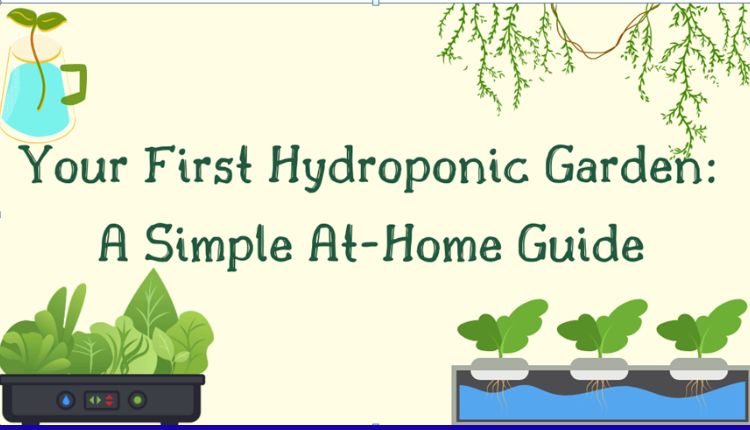Have you ever dreamed of snipping fresh basil for your pasta right from your own kitchen, even in a small apartment? The lack of a backyard no longer means you can’t enjoy the satisfaction of growing your own food. A simple, soil-free method called hydroponics is making it possible for anyone to set up a mini-garden on a countertop or a sunny windowsill. It sounds technical, but the basic concept is surprisingly straightforward.
What Exactly Is Hydroponics?
Before you start picturing a complex laboratory, let’s break it down. Hydroponics is simply the art of growing plants without soil. Instead of pulling nutrients from the dirt, the plant roots are suspended in a water-based solution packed with all the essential minerals they need to thrive. Think of it as a direct delivery service for plant food, eliminating the guesswork and mess of traditional gardening. This method allows you to control the environment perfectly, leading to faster growth and healthier plants.
Gathering Your Essential Supplies
Getting started is far less intimidating than it sounds. You don’t need a massive budget or a dedicated room; a simple starter kit can be assembled with just a few key items. This initial setup is your foundation for a successful indoor garden.
Here’s a basic checklist to get you going:
- A Container: A simple, opaque plastic storage bin or a 5-gallon bucket works perfectly. Opaque is important to prevent algae from growing in the nutrient solution.
- Net Pots: These small, basket-like pots hold your plants and allow the roots to grow down into the water.
- Growing Medium: Instead of soil, you’ll use an inert medium like clay pebbles or perlite to support the plant in the net pot. This material provides stability without affecting the nutrient balance.
- Hydroponic Nutrients: This is the most crucial part. You can buy pre-mixed liquid or powder nutrients specifically designed for hydroponics. They contain the perfect blend of macro and micronutrients.
- Seeds: Start with something easy. Leafy greens like lettuce or herbs like basil and mint are fantastic choices for beginners.
- An Air Pump and Air Stone: While not strictly necessary for every method, a small aquarium air pump and stone will oxygenate the water, preventing root rot and encouraging vigorous growth. It’s a highly recommended addition for any beginner’s deep water culture system.
Your Step-by-Step Setup Guide
With your supplies in hand, it’s time for the exciting part: assembling your first hydroponic system. This simple process should take less than an hour and will have you on your way to harvesting fresh greens in no time.
- Prepare Your Container: Cut holes in the lid of your container just large enough for the net pots to fit snugly. The number of holes depends on the size of your container and what you plan to grow.
- Set Up the Aeration: Place the air stone at the bottom of the container and run the airline tubing up and out. Connect it to your air pump.
- Mix the Nutrient Solution: Fill your container with water, leaving an inch or two of space at the top. Follow the instructions on your nutrient package to mix in the solution. Getting the concentration right is key to feeding your plants properly.
- Plant Your Seeds: Fill your net pots with your chosen growing medium, like clay pebbles. Plant a couple of seeds in each pot according to the seed packet’s instructions.
- Assemble and Position: Place the net pots into the holes on your lid, ensuring the bottom of the pots just touches the surface of the nutrient solution. Place the system in a spot that gets at least six hours of sunlight per day or under a grow light. Research shows that compared to traditional soil farming, these innovative gardening methods can increase yields while using significantly less space, making them perfect for urban homes.
Caring for Your New Green Friends
Your system is built, but the journey isn’t quite over. Thankfully, maintaining a small hydroponic garden with Hydroponics360 is much less work than a traditional one. A few minutes of attention every few days is all it takes to ensure your plants are happy and productive. Check the water level weekly and top it off with plain, pH-balanced water as needed. Every two to three weeks, you should completely drain the reservoir and mix a fresh batch of nutrient solution to ensure your plants are getting everything they need.
What to Grow First: Easy Plants for Beginners
Not sure what to plant? Starting with the right crops can make all the difference and build your confidence. Some plants are practically foolproof and adapt wonderfully to a simple hydroponic setup.
- Lettuce: Varieties like Buttercrunch or Romaine grow incredibly fast in a hydroponic system. You can be harvesting fresh salad greens in just a few weeks.
- Spinach: Another fast-growing leafy green that thrives in water.
- Herbs: Basil, mint, parsley, and cilantro are excellent choices. They don’t require intense light and having fresh herbs on hand will transform your cooking. You can find quality seeds for these from many online suppliers.
Frequently Asked Questions
1.How much does it cost to start a small hydroponic garden?
A simple DIY setup using a storage bin or bucket can be built for under $50. The main costs are the container, net pots, nutrients, and an optional air pump. Pre-made kits are also available and typically range from $80 to $200 for a small countertop system.
2.Do I need a special grow light?
If you have a window that receives 6-8 hours of direct sunlight per day, you may not need a grow light for simple greens like lettuce or herbs.
3.How long does it take to grow lettuce hydroponically?
Hydroponics can significantly speed up growth. From seed, you can often begin harvesting lettuce leaves in as little as 3 to 4 weeks, which is often faster than growing in soil.
4.Does hydroponically grown food taste different?
When done correctly, hydroponically grown produce should taste just as good, if not better, than soil-grown equivalents.






